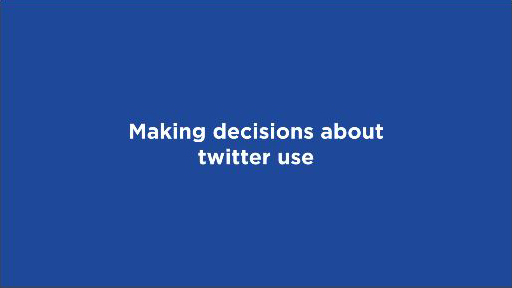3.1 Digital footprint
When we spend time online, we create a digital identity, that is, an identity associated with the actions we perform in online environments. These actions in turn create a digital footprint.

A digital footprint is a data trail that you create when you are online. It includes:
- Websites viewed
- Emails sent
- Information submitted through online forms
- Digital content uploaded e.g. photographs and posts
Your digital footprint can be passive or active. The passive footprint is left unintentionally, for example, when a website records your IP address and location or when your search engine stores your search history. In contrast, an active digital footprint consists of information you intentionally submit online.
Here, Olivia Kelly talks about specially about the use of Twitter and the public nature of the information you share. But many of the points she makes are relevant to all social media apps.

Transcript: Video 7 Making decisions about Twitter use
Research suggests that most students have good awareness of the concept of the digital footprint (Surmelioglu & Seferoglu, 2019) but that they would like to know more about how to ensure privacy and create a professional digital footprint (Buchanan et al., 2019). Many students know how to ensure privacy on their own accounts but recognise it is not possible to control disclosure because others can tag or share information that they were included in, for example, tagging them in a photo from a night out. One study found that 11% of students reported being tagged in photos which they had not wanted to be, and a further 11% reported being identified in unwanted comments. Five percent found information about themselves online that they did not think was public (Osborne and Connelly, 2016). Furthermore, even though students had good awareness of the footprint and their own privacy settings, research suggests that students had different views on what was acceptable on social media – and these views were less conservative that non-student members of the general public (Jain et al., 2014).
Activity 8 Search engines
Go to your preferred search engine (e.g. Google) and search for yourself. Look at the first page of results for both websites and images and then reflect on the following questions:
- Did you see anything on there that you did not expect to see?
- How would you feel if a prospective employer found this information?
Comment
The findings of this activity will be personal. For note, the author of this course once undertook this activity and found tweets that said “applying for any and all jobs at the moment, just need cash”. This shocked her as she hadn’t realised how public her tweets would be. Similarly, a friend had tagged her in a Facebook post that showed her at a rock concert. She has since changed settings on both these apps to ensure that her digital foot print is as positive and private as possible.
Research has identified something called the posting paradox on social media. This is the paradox that people post more risky content on the more public platforms. Miller and Melton (2015) found that students took greater risks on Twitter, where 69% of the participants had public accounts, in contrast to on Facebook, where only 14% had public accounts. This tells us that more can still be done to ensure a suitable digital footprint.
Activity 9 Tweet now, regret (years) later
Comment
We sometimes reveal things about ourselves online that we subsequently come to regret. We may also reply in anger or showing levels of emotion that we would not normally display in person. Jon Ronson’s book ‘So you’ve been publicly shamed’ documents how one person’s tweet went viral when she was on a flight, and documents how her life and professional career were catastrophically impacted. The impact of our social media content is illustrated well in the example of Paris Brown, who lost her role as Britain’s first Youth Police and Crime Commissioner when tweets she sent aged 14 years old in which she appeared to condone drug use and used derogatory terms resurfaced.
Even though there are various apps that can help you to clean up your digital footprint there is always a chance that posts can resurface, or go viral. So the safest way to engage in these spaces is to assume that everything you post has the potential to become public. Social media blurs the line between public and private communication. Be careful and considered in your posting to avoid trouble down the line.
